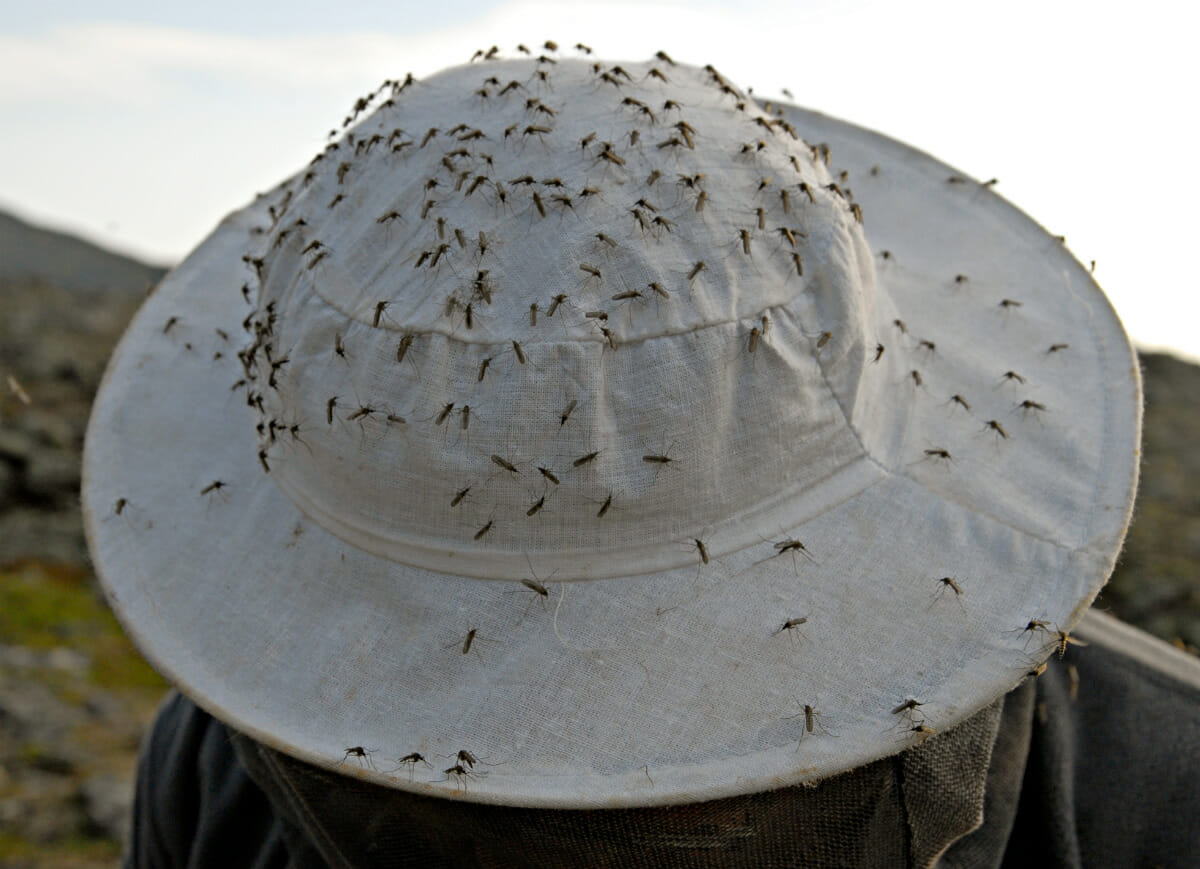War Is Hell: The Fight to Beat Mosquitoes
How do we hate thee? Let us count the ways.
War Is Hell: The Fight to Beat Mosquitoes
How do we hate thee? Let us count the ways.

To combat inconveniences ranging from moth-chewed blankets to oozing sores, homemakers consulted domestic guidebooks – almanac-style encyclopedias chock full of detailed solutions to tons of dilemmas. Bitten by a spider, snake, or other creepy crawly? Swaddle the area with a rag saturated in spirit of hartshorn (aqueous ammonia), made from the hooves and horns of a red deer. Or, better yet, track down a surgeon and have him cut out the itchy area, suggests Gunn’s Domestic Medicine, or Poor Man’s Friend in the Hours of Affliction, Pain, and Sickness, a go-to tome from the 1830s.
We continued to fixate on skeeters in the 20th century. The buzzers inspired a major propaganda campaign during World War II, thanks to the fact that they transmitted malaria. The mosquito-borne illness was responsible for nearly a half-million hospital visits and the deaths of 300 American soldiers. In response, the Army’s Medical Department assaulted malaria-addled areas with DDT or “bug bombs,” and produced posters and calendars reminding troops to fight the blood-sucking enemy. A 1943 Disney short – ordered by the government and starring the seven dwarfs – argued that “the winged scourge” was “public enemy number 1.” Doc, Dopey, and co. weed-whacked their way through swamps, demonstrating how to destroy the insects’ habitats.
We’ve battled different skeeter-borne illnesses over the last few decades. This summer, West Nile took a backseat to the Chikungunya virus. Transmitted by aedes mosquitoes, the virus was previously present in Africa and Asia and then popped up on the Caribbean island of St. Martin in December. By July, cases were recorded in Florida. The state still has the highest number of infections, with 138; New York ranks second, with 96. The virus, which causes fevers, nausea, and potentially debilitating joint pain, is rarely fatal, but is certainly painful enough to sideline infected individuals. (“It’s something sufferers would only wish on their worst enemies,” says William Schaffner, M.D., a professor of preventive medicine and infectious diseases at the Vanderbilt University School of Medicine.) Despite the low mortality risk, the virus has attracted a lot of attention – possibly because our contagion fears are on high alert as a result of Ebola outbreaks. Though there’s currently no specific treatment for Chikungunya, save run-of-the-mill fever reducers and painkillers, an experimental vaccine recently underwent its first trial.
Obviously, no one wants to be bug bait. Our contemporary habits for keeping ’em at bay range from slathering ourselves in DEET-filled sprays to lining windowsills with lavender-soaked ribbons. Some folkloric examples: barbecuing rosemary stalks, slathering on lemongrass pulp, lining your patio with pungent marigolds, and rubbing your skin with peppermint or spearmint leaves. Katie “The Wellness Mama,” a prolific eco-blogger, advocates a DIY spray made from essential oils, such as eucalyptus, cedar, catnip, or lavender, combined with witch hazel, distilled water, and vegetable glyercin.

Do these tactics pass muster? Dr. Schaffner isn’t totally sold. “It’s totally understandable to have a skepticism of chemicals,” he says. “But think of it this way: It’s ‘natural’ to develop appendicitis, but most of us would prefer not to – we’d call up a surgeon.” It’s the same with bug bites. “Citronella offers some protection, but it’s a modest effect,” he says. He figures, why get a dozen bites when you could just get one or two? While he doesn’t discourage people from setting out citronella candles during a backyard meal, he says that the scent won’t cut it when it comes to really repelling the insects. “If you’re seriously interested in avoiding being bitten by mosquitoes, DEET is the way to go,” says Dr. Schaffner.
For maximum protection, the CDC recommends slathering DEET-filled sprays on exposed skin and atop clothing. (FYI: Concentrations above 50% don’t seem to provide any noticeable benefit above concentrations in the 20%-50% range.) Dr. Schaffner thinks they’re safe bets.
But get this – turns out we all should have paid more attention to Disney’s whimsically fear-mongering video from the 1940s. One tried-and-true remedy involves eliminating standing water. We know that birdbaths and flowerpots quickly turn into mosquito breeding grounds, but we don’t tend to look up during our search-and-destroy missions. “If your gutters aren’t at the right pitch, they won’t properly drain, and will attract mosquitoes,” warns Dr. Schaffner. Fixing the angle can help evict the winged scourge, no chemicals necessary.
Follow us

This work is licensed under a Creative Commons Attribution-NoDerivatives 4.0 International License.
Want to republish a Modern Farmer story?
We are happy for Modern Farmer stories to be shared, and encourage you to republish our articles for your audience. When doing so, we ask that you follow these guidelines:
Please credit us and our writers
For the author byline, please use “Author Name, Modern Farmer.” At the top of our stories, if on the web, please include this text and link: “This story was originally published by Modern Farmer.”
Please make sure to include a link back to either our home page or the article URL.
At the bottom of the story, please include the following text:
“Modern Farmer is a nonprofit initiative dedicated to raising awareness and catalyzing action at the intersection of food, agriculture, and society. Read more at <link>Modern Farmer</link>.”
Use our widget
We’d like to be able to track our stories, so we ask that if you republish our content, you do so using our widget (located on the left hand side of the article). The HTML code has a built-in tracker that tells us the data and domain where the story was published, as well as view counts.
Check the image requirements
It’s your responsibility to confirm you're licensed to republish images in our articles. Some images, such as those from commercial providers, don't allow their images to be republished without permission or payment. Copyright terms are generally listed in the image caption and attribution. You are welcome to omit our images or substitute with your own. Charts and interactive graphics follow the same rules.
Don’t change too much. Or, ask us first.
Articles must be republished in their entirety. It’s okay to change references to time (“today” to “yesterday”) or location (“Iowa City, IA” to “here”). But please keep everything else the same.
If you feel strongly that a more material edit needs to be made, get in touch with us at [email protected]. We’re happy to discuss it with the original author, but we must have prior approval for changes before publication.
Special cases
Extracts. You may run the first few lines or paragraphs of the article and then say: “Read the full article at Modern Farmer” with a link back to the original article.
Quotes. You may quote authors provided you include a link back to the article URL.
Translations. These require writer approval. To inquire about translation of a Modern Farmer article, contact us at [email protected]
Signed consent / copyright release forms. These are not required, provided you are following these guidelines.
Print. Articles can be republished in print under these same rules, with the exception that you do not need to include the links.
Tag us
When sharing the story on social media, please tag us using the following: - Twitter (@ModFarm) - Facebook (@ModernFarmerMedia) - Instagram (@modfarm)
Use our content respectfully
Modern Farmer is a nonprofit and as such we share our content for free and in good faith in order to reach new audiences. Respectfully,
No selling ads against our stories. It’s okay to put our stories on pages with ads.
Don’t republish our material wholesale, or automatically; you need to select stories to be republished individually.
You have no rights to sell, license, syndicate, or otherwise represent yourself as the authorized owner of our material to any third parties. This means that you cannot actively publish or submit our work for syndication to third party platforms or apps like Apple News or Google News. We understand that publishers cannot fully control when certain third parties automatically summarize or crawl content from publishers’ own sites.
Keep in touch
We want to hear from you if you love Modern Farmer content, have a collaboration idea, or anything else to share. As a nonprofit outlet, we work in service of our community and are always open to comments, feedback, and ideas. Contact us at [email protected].by Jessica Leigh Hester, Modern Farmer
August 29, 2014
Modern Farmer Weekly
Solutions Hub
Innovations, ideas and inspiration. Actionable solutions for a resilient food system.
ExploreExplore other topics
Share With Us
We want to hear from Modern Farmer readers who have thoughtful commentary, actionable solutions, or helpful ideas to share.
SubmitNecessary cookies are absolutely essential for the website to function properly. This category only includes cookies that ensures basic functionalities and security features of the website. These cookies do not store any personal information.
Any cookies that may not be particularly necessary for the website to function and are used specifically to collect user personal data via analytics, ads, other embedded contents are termed as non-necessary cookies.